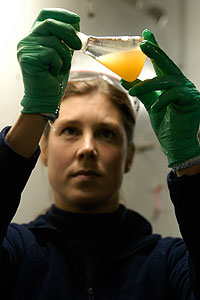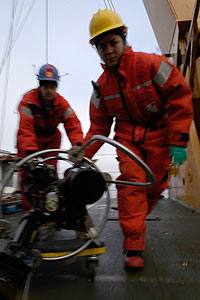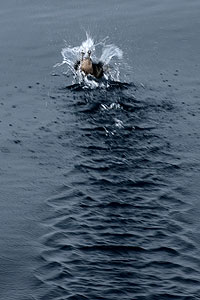|
|
 |
 |
 |
| Julia Linke checks an oxygen sample for bubbles. |
Click to enlarge
|
 |
 |
| Leopoldo Llinas (left) and Andrea Piehl (right) push the Video Plankton Recorder back to the garage after a cast. |
Click to enlarge
|
 |
 |
| A little auk dives for cover as the Healy steams by. |
Click to enlarge
|
Daily Update
Calendar
Dispatch 16 - September 16, 2004
By C. A. Linder
Weather conditions: Overcast skies, calm winds and seas, air
temperature 30°F
Northward Bound
One of the great things I have observed from my work area in the main
lab is the interaction between all of
the different scientists. Physical oceanographers, chemists, and biologists
all sit within arm's reach of one another, and each new discovery
sparks a round of discussion. These discussions often lead to changes
in the science plan as we struggle to make the most of our limited
time in this remote, inaccessible ocean.
This afternoon I caught up with chemical oceanographer Dave
Kadko to talk about the data he is collecting on this cruise.
Dave uses naturally occuring radioisotopes to trace oceanographic
processes like currents and eddies.
Dave, what are you measuring and why?
"I am measuring naturally occurring quantities of the radioisotope radium. Shelf waters absorb a trace amount of radium from the sediment on the seafloor. Once these shelf water parcels move into the deeper Arctic basins, it's like starting a stopwatch. The isotopes begin to decay, and by measuring the amount of radium that is remaining, we can then tell how long it has been since the parcel of water was on the shelf. As we move into deeper water in the next few days, the CTD team will be on the lookout for these swirling parcels of shelf water, called eddies. We hope to be able to determine how old these eddies are--it's a critical piece of information in the story of how shelf waters are transferred to the deep Arctic basins. One particular isotope of radium, (Ra-224) has a very short decay time (only a few days) and has never before been measured in the Arctic, so we're excited about what we will find."
Can you describe the process of collecting this data?
"First, we collect a huge volume of water using the CTD Niskin bottles, about 25-50 gallons for a single data point. We need this much because the radium is present in such minute amounts. Aaron Silverman and I then pump the water through filters that have an affinity for heavy metals. The fibers act like a sponge, and pick up the radium from the seawater. We then analyze these filters for their radium content, and preserve the samples for further analysis back in Miami."
The following questions about arctic wildlife are from Dr.
Linda Werner's sixth grade class at the Morse Pond School in Falmouth,
Massachusetts.
Question: Have you seen any wolves?
Answer: The island we left from, Unalaska, does not
have any wolves (though there are a lot of foxes). However, wolves
can be found in the Arctic, and Jim Johnson has been lucky enough
to see them while he was working on a research project on Ellesmere
Island, Canada. I asked him to describe that experience.
"We were staying at the Polar Shelf Research Station in Eureka, on St. Ellesmere Island in the Canadian Archipelago. One evening around 11pm (when it was still light out) we were visited by a pack of four wolves. Their fur was as white as the snow. We all stood at the window watching them wander around outside. We tried to take pictures through the window but decided it would be better if we opened the door. Opening the door startled them at first but they became very curious. As we stood in the doorway taking pictures, one of the guys ventured outside on his stomach and started taking pictures from that position. The wolves continued to get closer but would scatter if we moved too quickly. Slowly, more of us ventured outside with our cameras and the wolves just kept coming closer until they were about 5 feet away. They stayed around our building for about two hours then they just headed off into the hills. The whole time we never felt scared of them because they looked to be curious and comfortable, plus they have no real enemies on this particular island."
Question: Have you seen any sharks?
Answer: We have not seen any sharks, but there is
one species that inhabits the Arctic--the Greenland shark. It can
grow to be over 20 feet long, and is often seen swimming on the surface.
Inuit have used the shark's liver for fuel oil and the dried flesh
as food for their sled dogs.
Question: Are penguins shy or tame?
Answer: Penguins are actually found only in the Antarctic,
so I have never seen one in the wild. Some Arctic birds, such as murres
and guillemots, do look very penguin-like, though! Most seabirds I
have encountered are quite wary of humans, although the glaucous gulls
we have seen on this trip will sometimes fly overhead to check out
what we're doing.
Science
Crew Facts

Seth and his wife Jen designed and built their house outside of Fairbanks, AK. Their house is not connected to the power grid so they generate their own electricity with a wind turbine, solar panels and gasoline generator. |  |
Today we finished sampling at the mouth of Barrow Canyon with the
CTD, Video Plankton Recorder, and Multi-Net.
We are now northward bound, heading to the northern Chukchi Sea. Changes
in our ocean environment are already apparent. Standing on the foc'sle
after dinner, I observed hundreds of little
auks diving and splashing in the calm,
glassy waters. No bigger than a robin, the little auk, also known
as a dovekie, eats copepods and other tiny zooplankton. Judging from
the number I saw, this water must be brimming with life. Larger splashes
in the water were most likely ringed seals, although they were gone
in a flash. Tomorrow Jim Johnson and the Healy Marine Science Technicians
and Boatswain's Mates will be back in action--we will be recovering
the two University of Washington moorings. Click here for a diagram
of what these moored instruments look like.

|
Traducido al Español por
Andrea
|
El límite al norte
Una de las mejores cosas que he observado desde mi sitio en el laboratorio principal es la interacción entre los distintos científicos. Oceanógrafos físicos, químicos y biologos, todos se sientan y trabajan codo con codo, y cada nuevo descubrimiento desencadena una nueva ronda de discusion. Estas discusiones amenudo llevan a cambios en los planes cientificos, mientras luchamos por hacer lo maximo posible en este remoto e inaccesible oceano.
Esta tarde me puse a hablar con el oceanógrafo químico Dave Kadko sobre los datos que estaba recogiendo en la campaña. Dave usa radioisótopos naturales para trazar procesos oceanograficos como las corrientes y los eddies.
¿Dave, que estas midiendo y porque?
“Estoy midiendo la cantidad de radioisótopos de radio que hay en estado natural. Las aguas en placas continentales absorben una cantidad traza de Radio del sedimento del fondo. Una vez que estas aguas profundas se trasladan a aguas profundas de la cuenca ártica es como seguir una mancha. Los isotopos comienzan a decaer y al medir la cantidad de Radio que queda podremos decir cuanto tiempo ha pasado desde que la masa de agua estaba en la plataforma. A medida que nos movamos hacia aguas mas profundas en los próximos días, el grupo de la CTD va a trabajar en busca de estos remolinos de parcelas de agua llamados eddies. Esperamos ser capaces de determinar la edad de estos eddies, que es una de las principales claves para saber como las aguas de la plataforma entran en la cuenca del Ártico. Un isótopo de Radio en particular (Ra-224) tiene un tiempo de vida muy corto (solo unos cuantos dias) y nunca ha sido medido en el Ártico, asi que estamos intrigados con lo que vamos a encontrar.”
¿Puedes describirnos el proceso de recolección de los datos?
“Primero cogemos una gran cantidad de volumen de agua usando las botellas Niskin de la CTD, cerca de 25-50 galones para un solo punto. Necesitamos tanto porque el Radio esta
presente en muy pequeñas cantidades. Entonces Aaron Silverman y yo bombeamos el agua a traves de filtros que tienen una afinidad por los metales pesados. Las fibras actuan como una espnja, y recogen el Radio del agua de mar.Entonces analizamos estos filtros para ver el contenido de Radio y los preservamos para futuros analisis cuando volvamos, en Miami”
La siguientes preguntas sobre la vida salvaje en el Ártico nos la
hace la clase de sexto grado de la Dr. Linda Werner en Morse
Pond School en Falmouth, Massachusetts.
Pregunta: ¿Habeis visto algun lobo?
Respuesta: En la isla de donde partimos, Unalaska,
no tiene lobos (aunque hay muchos zorros). Aunque se pueden encontrar
lobos en el Artico y Jim Johnson tuvo la suerte de verlos cuando estaba
trabajando en un proyecto de investigacion en la isla de Ellesmere,
Canadá. Le pregunte sobre su experiencia.
“Estabamos en la Estacion de Investicacion de la Plataforma Polar en Eureka, en la isla de St. Ellesmere del Archipiélago Canadiense. Una noche a las 11pm (aun era de dia allí fuera) recibimos la visita de un grupo de cuatro lobos, lo cuatro tan blancos como la nieve. Estabamos todos mirandolos a traves de la ventana, intentando hacerles fotos, cuando decidimos que sería mejor que si abrimos la puerta. El abrir la puerta les puso en alerta al principio, pero luego empezaron a sentir curiosidad. Mientras estábamos en la puerta tomando fotos uno de nosotros se aventuro a salir arrastrándose sobre su estómago para tomar unas fotos en esta posición. Los lobos continuaban acercandose, pero se asustaban si nos moivamos muy rápidamente. Poco a poco nos ibamos aventurando afuera con nuestras cámaras y los lobos seguian acercándose hasta que estuvimos a casi 5 pies de distancia. Estuvieron dando vueltas alrededor de nuestra construcción sobre dos horas hasta que volvieron a esconderse entre las colinas. En todo el tiempo que estuvieron no tuvimos miedo de ellos porque parecian estar comodos y un poco curiosos, aunque no tienen verdaderos enemigos en estas islas.”
Pregunta: ¿Habeis visto algun tiburón?
Respuesta: No hemos visto ningun tiburón pero hay
una especie que vive en el Ártico, el tiburón de Groenlandia. Puede
llegar hasta los 20 pies de longitud y normalmente nada por la superficie.
Los Inuits usaban el hígado de estos tiburones como fueloil y tambien
la carne la usaban para alimentar a los perros de trineo.
Pregunta: ¿Los pingüinos son tímidos o dóciles?
Respuesta: Los pingüinos solo se encuentran el la
Antartida, nunca les he visto libres, aunque algunas aves del Artico
se parecen mucho a los pingüinos. La mayoría de los pajaros que hemos
visto son muy cautelosos con los humanos, aunque algunas gaviotas
articas que hemos visto en esta campaña volaban a veces sobre nuestras
cabezas para saber lo que estabamos haciendo.
Hoy terminamos de muestrear la boca del cañón de Barrow con la CTD, Video Plankton Recorder y la Multi-Net. Estamos en el límite al norte, en la cabecera norte de el mar de Chukchi. Los cambios en el medio ambiente oceanico son ya apreciables. Mirando en a proa después de la cena pude observar cientos de pájaros “auk” buceando y chapoteando en las calmadas y cristalinas aguas. No mas grande que un petirrojo, el pequeño “auk” come copepodos y otros tipos de zooplancton. Según el número que yo vi, esta aguas tienen que estar llenas de vida. Chapoteos mas grandes en el agua serian probablemente de focas, aunque desaparecieron enseguida. Mañana Jim Johnson y los técnicos marinos y demás colegas vuelven a la accion, recogeremos los moorings de la Universidad de Washington. Haga Clic aquí para ver como son estos instrumentos anclados.
 Previous
Dispatch
Next Dispatch Previous
Dispatch
Next Dispatch

Back to Calendar
|
|




